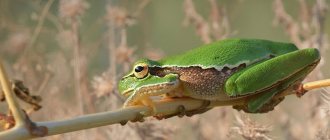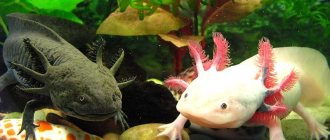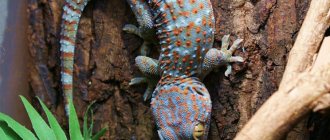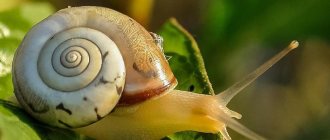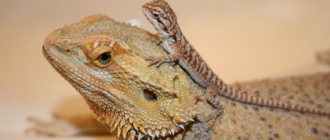The Yemen chameleon (lat. Chamaeleo calyptratus) is a fairly large species that is difficult to keep. But, at the same time, interesting and unusual, although the word ordinary is unlikely to suit any of the representatives of the family. Yemen chameleons are regularly bred in captivity, which has made them quite common as they are more adaptable and live longer than those caught in the wild. But, nevertheless, it cannot be called simple in content. And from the article you will find out why.
Appearance of a domestic Yemeni chameleon
Among all the chameleons found on the planet, the Yemeni chameleon is one of the largest. Males often reach 55 cm in length, females are slightly smaller - up to 35 cm.
The easiest way to determine the sex of the Yemen chameleon is from the first weeks of life - on the hind legs of males, heel spurs are visible at the base of the hands. Females lack spurs from birth. As males age, their spurs become larger and their helmet increases in size. Females have a much less impressive crest.
Another way to distinguish a male in adults is to look at its color. Males have vertical stripes of orange or yellow.
The coloring of reptiles is varied. It can vary from green to black, and multi-colored patterns are often found on the skin.
Habitat in nature
As you can easily guess from the name, the birthplace of the species is Yemen and Saudi Arabia.
Although these countries are considered desert, chameleons live in coastal areas that regularly receive heavy rainfall and in drier valleys, but with plenty of greenery and water.
Also introduced and established on the island of Maui (Hawaii) and Florida.
In the past, Yemen chameleons were rarely seen in captivity, as wild ones did not take well to even experienced terrarium keepers.
However, over time, individuals bred in captivity were obtained that were much more adapted. So most of the individuals found on sale are locally bred.
Arrangement of the terrarium
To ensure that your pet is in a good mood, does not experience stress, or gets sick, it needs to be placed in a spacious vertical terrarium. Much attention should be paid to ventilation - it should be flowing.
Chameleons are prone to respiratory diseases. The air should not be allowed to stagnate.
There should be enough space per adult. For a male - 60x45x90 cm, for a female - 45x45x60 cm (L x W x H). But if you have the opportunity to expand it, it will only be better.
In nature, reptiles spend a lot of time in trees, so snags with many branches are installed inside the terrarium, and vines are suspended. Chameleons love to camouflage and experience stress in open areas. At home, this needs to be compensated by increasing the amount of foliage on the branches, albeit artificial.
It is best to use woody soil as a substrate. It holds moisture well and does not mold.
How to do it yourself?
Today you can buy a terrarium at almost any pet store, as well as from chameleon breeders. Manufacturers offer a wide range of different designs that differ in size, design, materials and other parameters.
The downside of store-bought containers is their high price. Not everyone can afford to purchase an expensive terrarium to keep an exotic pet. There is a way out - to assemble a house for the chameleon yourself.
First of all, you will need to determine the dimensions of the future structure. To do this, it is worth considering:
- type of chameleon;
- dimensions;
- conditions of detention.
It is also recommended to look for or develop a drawing of the future terrarium in which the exotic animal will live. It is necessary to put dimensions on the finished diagram so that later it will be more convenient to assemble the structure.
When the drawing is ready, you can begin preparing materials and tools. To assemble a chameleon terrarium with your own hands, you will need:
- plexiglass;
- rug in green shades;
- UV lamp;
- transparent silicone sealant;
- air ionizer;
- metallic profile;
- dried tree branches;
- heated mat to organize effective thermoregulation of reptiles;
- artificial plants and trees;
- greens planted in pots;
- knife for construction work;
- scissors;
- manual welding machine;
- Bulgarian.
Additional tools may be required during the process. In most cases, they are at hand, so there will be no problems finding the tools. Stages of assembling a terrarium.
- First you need to take prepared metal profiles and weld a rectangular frame from them.
- Next, you need to install the glass on the frame - this will be the basis of the terrarium.
- The third stage involves the installation of side walls. The joints should be lubricated with sealant to prevent any leaks or deformation of the container. Sometimes during the drying process of the sealant there is a risk of the terrarium becoming distorted. To prevent this from happening, it is worth using belt ties.
- After this, the container will need to be wiped and a heated mat placed on the bottom. You must first provide a hole in the corner of the terrarium where the wires will be routed. At this stage it is also worth installing an air ionizer.
The wire outlet area can be sealed using silicone sealant. When the main work is completed, all that remains is to arrange a terrarium for the pet.
Temperature, humidity and heating methods
Since the reptile lives in a warm, humid climate, it is necessary to create a similar atmosphere indoors. The main source of heat is lamps. Depending on the size of the terrarium and the room temperature, light bulbs of varying power from 25 to 150 watts are selected.
The lamps are placed in the upper part of the terrarium above the mesh. Be sure to use thermometers to monitor the temperature so you always have an idea of how comfortable your reptile is inside. Light bulbs must be turned off when daylight hours are over for your pet.
The Yemen chameleon is a cold-blooded animal. This means that if the outside temperature drops too much, the chameleon may get sick or die. The optimal temperature range for keeping is 27-29 degrees. A special heating point is also created inside, where the temperature increases to 35 degrees. This will allow the reptile to move to a warmer zone according to its mood for proper digestion of food.
Night temperatures are below standard and range from 22 to 24 degrees. A decrease to a level of 14-15 degrees is considered critical for the animal.
You should also pay attention to humidity. Comfortable rates for living are from 20 to 55%. High humidity stimulates the appearance of problems with the respiratory system, and low humidity stimulates skin diseases.
Description
The Yemen chameleon is a fairly large lizard; males (which are always larger than females in all members of the family) can reach up to 60 cm, including the length of the tail. They have a much more variegated color.
Against the general bright green background of the body, 3 yellow longitudinal spots contrastingly stand out on the sides, alternating with bright yellow or orange and brown transverse stripes. The head has a flattened comb-like appendage, the height of which can reach 7-8 cm.
In females, this growth is not pronounced and usually represents a barely noticeable elevation. The tail is very strong, grasping, performs the function of a “fifth limb”, covered with green and yellow-brown alternating stripes and spots, until its very end.
When at rest, the tail is usually curled into a spiral. The body of chameleons is noticeably flattened laterally. The paws have an interesting structure: 4 fingers on them are sharply divided in pairs in such a way that 2 of them are opposed to the other two. This foot structure allows the lizard to rest securely on tree branches. The legs of males are more massive, especially the hind legs.
A well-known feature is the ability to change color quite quickly. Mainly used for camouflage on various surfaces.
In general, it is not the color itself that is transformed, but its overall tone, while the arrangement of spots and stripes remains constant. The modification of the color of chameleons is associated with the structure of their skin.
In the outer fibrous and deeper layer there are special branched marker cells - chromatophores, containing grains of various pigments - yellow, brown, black and red.
When the outgrowths of chromatophores are reduced, these grains are redistributed, and their largest accumulation appears in the central part of the cells and the lizard acquires the corresponding shade. When black pigment is concentrated in the upper part of the skin, it becomes dark in color.
The combination of both layers results in different color shades. The animal turns green as a result of the refraction of light rays in the surface layer of the skin containing guanine crystals.
Food and diet
When keeping a Yemeni chameleon at home, you will have to feed the reptile with insects. The most commonly eaten food items are crickets, locusts and caterpillars. At least once a week it is worth diluting the diet with plant components and giving your pet fresh leaves.
The feeding regimen is selected individually depending on the age and size of the reptile.
| Age (in months) | Feeding frequency | Type and amount of food (per meal) |
| 1-6 | Daily | 10 crickets |
| 6-12 | In one day | Up to 15 crickets or 3-5 locusts |
| From 12 | 2-3 times a week | 15-20 crickets or 3-7 locusts |
To feed the reptile with useful substances, you need to take care of insect pollination. They are sprinkled with special vitamins or calcium. Insects can be fed either with tweezers or released inside the terrarium and watch how your pet catches them with its tongue. Food should be given only in the morning and afternoon. Feeding in the evening is not recommended.
It is better not to limit yourself only to insects and periodically introduce plant foods into your diet. Reptiles especially love juicy fruits and berries. They can be fed from the second month of life.
Take care of the correct drinking regime. Since in the wild Yemen chameleons usually feed on dew, they should only be given fresh water. It is best to install a drip drinker or waterfall. At least twice a day, the terrarium should be sprayed with clean water from a spray bottle, then the pet will be able to lick the remaining droplets from the leaves and quench its thirst.
It is IMPORTANT to carefully monitor the chameleon’s drinking, teach it to lick droplets of water when sprayed, and, if necessary, supplement it with a syringe (without a needle).
If the mountain doesn't move...
A chameleon looks funny when it decides that its prey will not get close enough to attack: in such cases, it slowly begins to move in the desired direction. With one eye he fixates on the target, with the other he tirelessly examines the surroundings. With a barely noticeable movement, he lifts his front leg, moves it forward slightly, releases it and moves his tail forward, having first moved his hind leg. Moreover, the limbs are able to move like this: first the left, then the right, and not alternately, as we are used to seeing in other quadrupeds. All this is completely silent and looks like slow motion.
By the way, despite the fact that chameleons prefer a sedentary lifestyle, if necessary, they can run quite quickly and even jump from branch to branch.
Cleaning and hygiene rules
Insect remains and excrement must be promptly removed from the terrarium. This is done with tweezers at least once a week. Use damp cloths to wipe glass. In our store you will find glass cleaning products that have a disinfecting effect.
If you use substrate to lay on the bottom, mushrooms may grow on it over time. This is fine. The periodic appearance of midges is also not dangerous - after some time they will disappear on their own.
Reproduction of individuals
Individuals reach sexual maturity at 9-12 months. And if you place a couple of reptiles of different sexes in one terrarium, then perhaps they will give birth to offspring. The main thing is that they do not become aggressive. If the female responds favorably to the courtship of the gentleman, then several matings will occur until she darkens. When her body color changes, the process is completed and she begins to chase the father of the future offspring.
After 4-4.5 weeks she will be busy looking for a place to lay, it is recommended to place wet vermiculite or fibers in the tank. As a rule, females lay up to 8-8.5 dozen eggs, the incubation period of which lasts 5-10 months. It is easier to care for the offspring if you move them to a separate incubator container.
The Yemeni chameleon is an amazing creature that can evoke different emotions. But the owners unanimously say that they cannot find a better pet - one that is as original, spectacular and interesting. To keep him healthy and feel good, it is important to take into account his natural needs.
First contact with a person
When you first bring your reptile home, you need to disturb the animal as little as possible to reduce stress and allow the chameleon to adapt to its new location.
To make the chameleon get used to you faster, we recommend hand-feeding it at first. Sometimes you can take your pet out and hold it in your arms.
Gradually, the reptile will get used to you and will even crawl into your arms. There are also especially friendly individuals who spend a lot of time with a person and become strongly attached to him.
If the chameleon is outside the terrarium, you need to make sure that the room is clean and free of other animals and drafts. We do not recommend leaving the reptile outside its special habitat.
To start or not?
Today, the inhabitants of home exoterrariums are a variety of species of lizards: from iguanas to geckos. Some people who like to tickle their own nerves even get huge monitor lizards or snakes. And, of course, the specifics of keeping this pet (temperature conditions, feeding ration, and care nuances) completely depend on who exactly will live in your terrarium. Therefore, it is not enough just to familiarize yourself with the general recommendations for keeping reptiles in the house; you need to study in detail all the available information about exactly the species that you are planning to keep. Indeed, despite their rather repulsive appearance for many people, snakes, iguanas and other creatures in reality are very fragile and vulnerable creatures. This is especially true for chameleons - the strangest and most mysterious inhabitants of planet Earth.
Chameleons are medium-sized insectivorous lizards that most often live on tree branches. The unique ability of these creatures is that they can use camouflage (the color of a chameleon can vary from gray to light green). With such changes in skin tone, it can be extremely difficult to see them in the mass of foliage.
It is this feature that has become a fashionable “trick” of chameleons, which most of all attracts exotic fans to reptiles. This is why chameleons so often become pets to be proud of and show off. However, simply having such a lizard and providing it with the most comfortable living environment is not the same thing. Beautiful creatures by nature have weak immunity and vulnerability to various kinds of diseases - therefore they require especially careful and painstaking care.
Are you ready to create conditions for this creature that ideally replace its usual habitat? Will you be able to take good care of him and devote time to him? These questions are worth thinking about even before you buy a pet.
Interesting Facts
- The Yemen chameleon is one of the most aggressive and largest species in the entire chameleon family.
- It is known that the tongue of this reptile is often 1.5-2 times longer than its entire body. Its structure is such that in the resting position it is located in the mouth, held by the cartilaginous bone of the lower jaw. At the moment of attack on prey, the lingual muscle tenses and, with the help of cartilage, the organ is sharply pushed out, then it relaxes, and the lizard pulls it back into the mouth.
- The Yemen chameleon is the most common species among reptile enthusiasts. Every day, all over the world, a huge number of these animals are sold.
It received its name from the region where the species was originally described—the western coast of Yemen, where it still lives. They also inhabit the Arabian Peninsula on the southwestern coast of Saudi Arabia in the wild. They live on the branches of various types of tropical trees.




